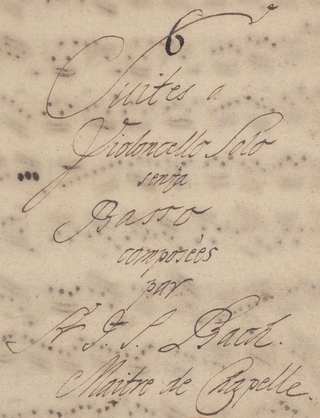
Partita was originally the name for a single-instrumental piece of music, but Johann Kuhnau, his student Christoph Graupner, and Johann Sebastian Bach used it for collections of musical pieces, as a synonym for suite.

The six Cello Suites, BWV 1007–1012, are suites for unaccompanied cello by Johann Sebastian Bach (1685–1750). They are some of the most frequently performed solo compositions ever written for cello. Bach most likely composed them during the period 1717–1723, when he served as Kapellmeister in Köthen. The title given on the cover of the Anna Magdalena Bach manuscript was Suites à Violoncello Solo senza Basso.
An air is a song-like vocal or instrumental composition. The term can also be applied to the interchangeable melodies of folk songs and ballads. It is a variant of the musical song form often referred to as aria.
The French overture is a musical form widely used in the Baroque period. Its basic formal division is into two parts, which are usually enclosed by double bars and repeat signs. They are complementary in style, and the first ends with a half-cadence that requires an answering structure with a tonic ending. The second section often but not always ends with a brief recollection of the first, sometimes even repeating some of its melodic content.

Trevor David Pinnock is a British harpsichordist and conductor.

The sonatas and partitas for solo violin are a set of six works composed by Johann Sebastian Bach. They are sometimes referred to in English as the sonatas and partias for solo violin in accordance with Bach's headings in the autograph manuscript: "Partia" was commonly used in German-speaking regions during Bach's time, whereas the Italian "partita" was introduced to this set in the 1879 Bach Gesellschaft edition, having become standard by that time. The set consists of three sonatas da chiesa in four movements and three partitas in dance-form movements. The 2nd Partita is widely known for its Chaconne, considered one of the most masterly and expressive works ever written for solo violin.
D major is a major scale based on D, consisting of the pitches D, E, F♯, G, A, B, and C♯. Its key signature has two sharps. Its relative minor is B minor and its parallel minor is D minor.
A minor is a minor scale based on A, with the pitches A, B, C, D, E, F, and G. Its key signature has no flats and no sharps. Its relative major is C major and its parallel major is A major.
E minor is a minor scale based on E, consisting of the pitches E, F♯, G, A, B, C, and D. Its key signature has one sharp. Its relative major is G major and its parallel major is E major.
B minor is a minor scale based on B, consisting of the pitches B, C♯, D, E, F♯, G, and A. Its key signature has two sharps. Its relative major is D major and its parallel major is B major.

The Partita in D minor for solo violin by Johann Sebastian Bach was written between 1717 and 1720. It is a part of his compositional cycle called Sonatas and Partitas for Solo Violin.

The four orchestral suites BWV 1066–1069, are four suites by Johann Sebastian Bach from the years 1724-1731. The name ouverture refers only in part to the opening movement in the style of the French overture, in which a majestic opening section in relatively slow dotted-note rhythm in duple meter is followed by a fast fugal section, then rounded off with a short recapitulation of the opening music. More broadly, the term was used in Baroque Germany for a suite of dance-pieces in French Baroque style preceded by such an ouverture. This genre was extremely popular in Germany during Bach's day, and he showed far less interest in it than was usual: Robin Stowell writes that "Telemann's 135 surviving examples [represent] only a fraction of those he is known to have written"; Christoph Graupner left 85; and Johann Friedrich Fasch left almost 100. Bach did write several other ouverture (suites) for solo instruments, notably the Cello Suite no. 5, BWV 1011, which also exists in the autograph Lute Suite in G minor, BWV 995, the Keyboard Partita no. 4 in D, BWV 828, and the Overture in the French style, BWV 831 for keyboard. The two keyboard works are among the few Bach published, and he prepared the lute suite for a "Monsieur Schouster," presumably for a fee, so all three may attest to the form's popularity.
Laszlo Varga was a Hungarian-born American cellist who had a worldwide status as a soloist, recording artist, and authoritative cello teacher.

The Partita No. 3 in E major for solo violin, BWV 1006.1, is the last work in Johann Sebastian Bach's set of Sonatas and Partitas. It consists of the following movements:
- Preludio
- Loure
- Gavotte en Rondeau
- Menuets
- Bourrée
- Gigue
The Partita in A minor for solo flute, BWV 1013, is a partita in four movements composed by Johann Sebastian Bach. Its date of composition is uncertain, though on the basis of its advanced playing technique, which is more demanding than in the flute part for the Fifth Brandenburg Concerto, for example, it must have been written after 1723. The title, however, is the work of 20th-century editors. The title in the only surviving 18th-century manuscript is "Solo p[our une] flûte traversière par J. S. Bach".
This is the discography for Tanya Anisimova.
The Suite in C minor, BWV 997, by Johann Sebastian Bach, exists in two versions: